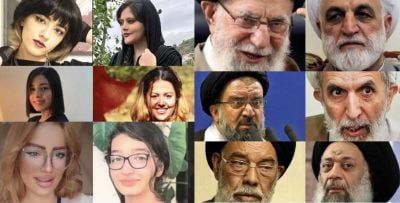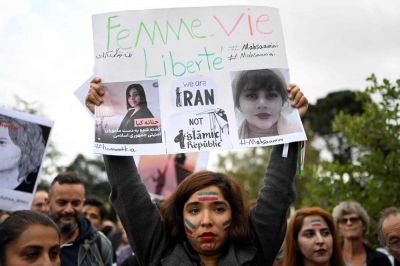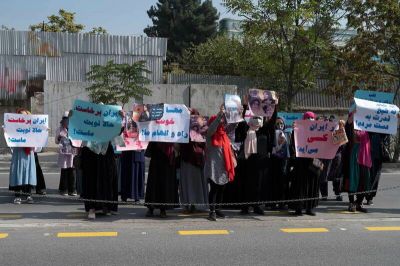A handful of Afghan women holding placards during a protest outside the Iranian embassy in Kabul in support of the protest movement in Iran, Sept. 29, 2022. (Credit: Wakil Kohsar/AFP)
Wafa Mustafa, a Syrian activist who fled her homeland in 2013, is very well acquainted with the feeling of uncertainty if she would return home after a demonstration, be killed in the streets of her city, or be arrested by the regime’s forces.
When she saw the scenes of protests that have been shaking Iran for more than three weeks, these feelings resurfaced in her.
“This fear that you feel is what we share with Iranians. What’s happening there seems so familiar,” Mustafa told L’Orient-Le Jour.
From Tunisia to Afghanistan, to Lebanon, Syria, Iraq, and Yemen: for many in the region, the protest movement in Iran awakens not-so-distant memories.
“But I try not to focus on Syria,” said Mustafa. “This will lead nowhere.”
Mustafa, in her 30s, is currently based in Berlin. Having not had any news from her father for over nine years, she makes sure to report on the fate of the disappeared persons under the Assad regime.
“Certainly, the Syrian and Iranian people have a common enemy,” she said in reference to Tehran, one of the main sponsors of the Damascus government.
Undoubtedly, the fall of the regime in Iran will have repercussions in Syria.
“But it is not for these reasons that I feel so strongly about the Iranian cry of anger,” Mustafa said. “I believe above all that everyone deserves to be free.”
This reaction runs counter to the silence observed by the leaders of the Middle East and the Arab world, fearing a scenario similar to that of the Arab Spring.
On Oct. 3, Iran’s Supreme Leader Ayatollah Ali Khamenei denounced what he called a plot by the United States and Israel. Meanwhile, Hezbollah leader Hassan Nasrallah described the death of Mahsa Amini as a “mysterious incident.”
The fallout in the surrounding countries
Since the suspicious death of the 22-year-old Kurdish woman on Sept. 16, the whole country has been ablaze. Three days earlier, she had been arrested by the morality police for violating the Islamic Republic’s dress code.
What began as a feminist uprising quickly turned into an unprecedented challenge to the mullahs’ regime. At least 154 protesters have been killed since mid-September, according to the Oslo-based NGO Iran Human Rights.
While it is still too early to predict the outcome of the protest movement, there is no doubt that the point of no return has been reached for the Iranian authorities.
In recent days, the scenes taking place in the country’s streets are on a scale not seen since 2009, when the green revolution failed. Whether it is a revolt or a revolution, the current uprising reflects the profound changes that have been taking place in Iranian society in recent years.
These images take on a special dimension in the countries where Tehran’s proxies are present.
“I do not believe in the fall of the Iranian regime, whose roots are almost unshakeable. Much stronger than those of Saddam Hussein’s regime in Iraq,” said Ali al-Mikdam, an Iraqi journalist and founder of the Iraq Future Center for Democracy Support.
Yet the fallout could already be felt in Iraq, he added.
“The more problems there are in Iran, whether social, economic or even political, the more the country is forced to focus on managing its internal affairs, which weakens its hold on the region, whether in Iraq, Yemen, Lebanon or Syria,” he explained.
Following the protests in Iran with fervor and admiration, Baraa Shiban, a Yemeni activist, does not believe in the Iranian regime will fall.
“It has a large and solid police structure and will not be brought down so easily,” he told L’Orient-Le Jour.
He is, however, pleased to see that the protest movement is ongoing despite the repression and crackdown.
Active during the protests that shook his country in 2011, Shiban was forced to leave Yemen in 2015 when the Iran-backed Houthi rebels took control of the capital, Sanaa.
For him, the protests led by a part of the Iranian population reveal a reality that the regime tries to hide at all costs.
“Iran has long claimed that the Islamic revolution does not stop at its borders and that it is important for other countries to follow the Iranian model. It is therefore necessary for Tehran to show that all is well. But the demonstrations prove exactly the opposite,” he said.
For him, the timing is symbolic.
In the midst of nuclear negotiations to reactivate the Vienna agreement from which former US President Donald Trump withdrew, it is as if Tehran is caught up with its old demons.
In recent days, the European Union and the US have announced that new sanctions would soon be imposed on Iran in the face of human rights violations in the country, with the UK announcing sanctions against Iran’s morality police and political officials on Monday, without wanting to jeopardize the talks on the Vienna agreement.
“The West must suspend the talks,” Shiban believes.
Structural change in the regime
In Lebanon, where the Iranian question has been a political fault line for years around the pro- and anti-Hezbollah divide, the Iranian protests have a particular significance.
This is especially true since the Iran protests come just three years after the Lebanese popular protest movement, which many young people have not yet digested how this uprising fizzled out.
Dima Ayache, a member of the political network of youth in Lebanon, Mada, who was active during the thawra (revolution), believes that we cannot compare one uprising to another. But she sees many common points between the revolt in Lebanon and the protest movement in Iran.
“Whether our demands are similar or different, we are both asking for a structural change in the system, for our freedom,” Ayache told L’Orient-Le Jour.
Beyond the Middle East, the wave of support for Iran has reached the Maghreb, where women participated alongside men in the protests that broke out in Tunisia in 2011 and in Algeria in 2019.
Najet Zammouri, vice president of the Tunisian League for Human Rights, was outraged when she saw the angry scenes in Iran but not surprised.
“Religious autocratic regimes are capable of any violent act against women,” she said.
Although the situations are very different, the current struggle of the Iranian people for their rights inspires her not to give up in her own country.
“If Tunisia is considered at the forefront of Muslim and Arab countries in relation to women’s rights, we have felt the regression from 2011,” she explained.
“The Islamist party with the electoral majority at that time tried to amend the code of personal status to remove rights such as monogamy and civil marriage. Some followers of this political party even called for the mandatory wearing of the veil,” said Zammouri who remains optimistic that the country will soon see a revolution leading to a change of the regime.
Zoya, who left Afghanistan eight months ago to seek refuge in neighboring Pakistan, does not share the same view.
While she learned about the protest movement in Iran from friends in the country, she quickly moved on.
“I am also a woman, and my situation is horrible,” she said.
Last summer, she watched from a distance and without much hope as a handful of women’s protests were dispersed by Taliban authorities in her country.
“I knew that nothing was going to change. Everything is political, when the whole government is against you, nothing will change,” Zoya said.
Beyond the emotions that it awakens, the Iranian uprising brings back to the forefront questions that have plagued the countries of the region for years.
Do the people have the power to change the destiny of a nation? How can a popular revolt be transformed into a political revolution?
This article was originally published in French with L'Orient-Le Jour. Translation by Sahar Ghoussoub.


